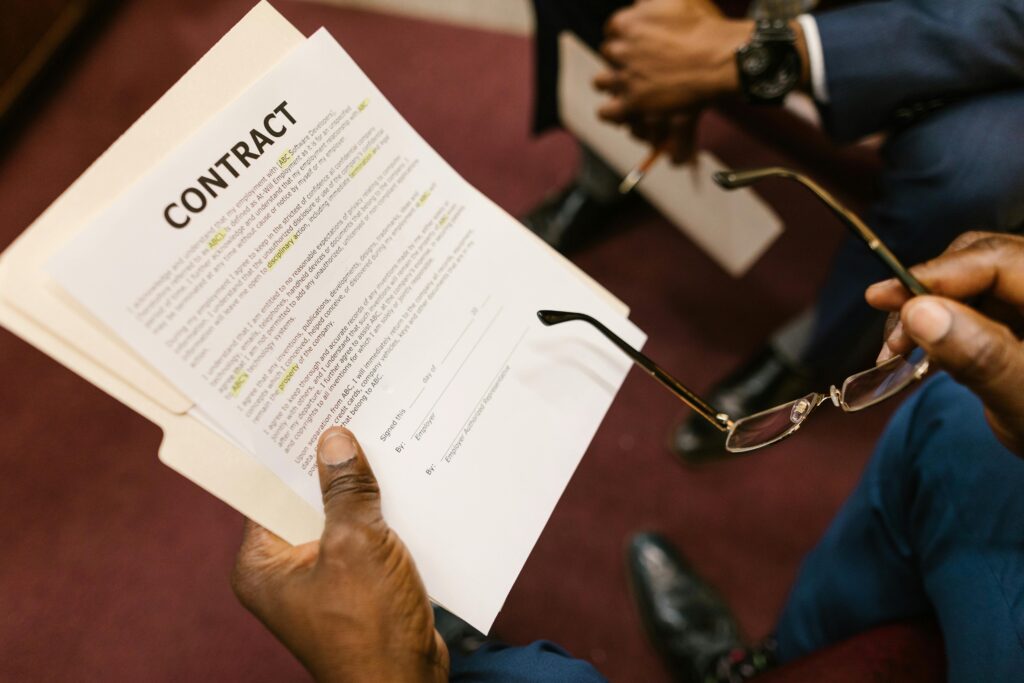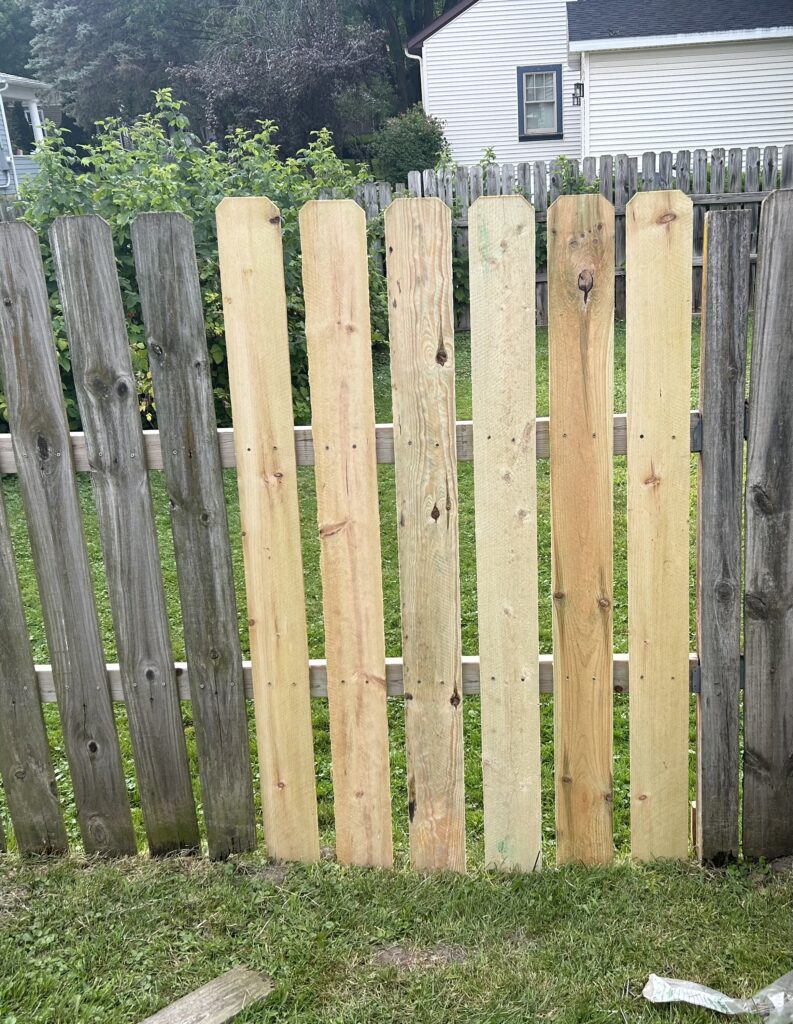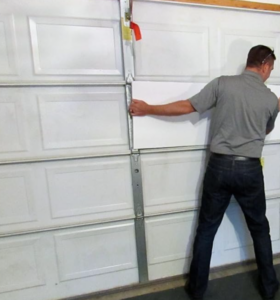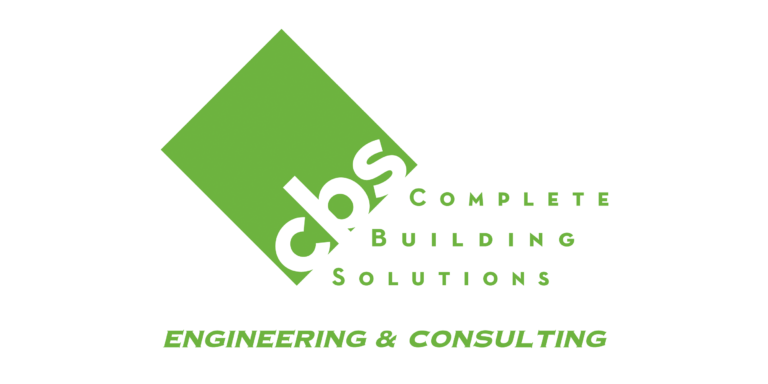Are you looking to create a secure and private outdoor space at your home? A privacy fence may be just what you need. But where do you even begin? In this guide, we will cover everything you need to know about privacy fences- various uses, types, materials, installation tips, maintenance advice and even how to go about checking your city regulations.

Let’s dive into the world of privacy fencing!
What Is A Privacy Fence?

A privacy fence is a fence that does exactly what its name implies, creates a barrier of privacy for your home. Living in a neighborhood has its benefits, but let’s be honest, who wants their neighbors watching their every move?
Installing a privacy fence can act as a barrier around your property line and also provide a peaceful place where your family can relax without feeling like they live in a fish bowl.
Want more specifics? Keep reading.
How Tall Are Privacy Fences?

Most privacy fences are around 6 feet tall. A 6 foot tall fence does screen off the area and has the added benefit of securing pets inside the space (unlike a 4 foot fence that an athletic dog can jump with ease).
6 feet is typically the maximum height you can build your fence without getting permission and a building permit from your city. We are referring to backyards and the side of your home here only.
Most cities and municipalities will not allow this height for front yards; typically the height permitted is 3-4 feet high.
This leads into our next question, permitting for privacy fences.
Can I Build A Privacy Fence Without A Permit?

Many people are shocked when they find out they may need a building permit from their city to install a privacy fence. It’s important to know that there is no universal regulation here. Each city government is different. To know what your city requires, go to their website or call their building department.
Golden Valley, Minnesota has an easy to read PDF (see below) on their website that lays out the expectations for fence construction. Every fence requires a zoning permit (click the link to see the example), but only fences over 6 feet and those located on floodplains require a building permit.
The zoning permit will require homeowners to provide a detailed and accurate site plan that includes existing and proposed structures. They even require you to list the structure design including size, style and construction materials.

Keep in mind that there are various situations where your city building department may require a design from a structural engineer prior to issuing you a building permit. We have run into this several times when a homeowner is building on poor soils. The building department may require a special footing to be constructed requiring a structural engineer drawing.
Can A Privacy Fence Be On The Property Line?

Privacy fence requirements are based on local regulations therefore some cities may allow fencing built on the property line while others may not.
For instance, the city of Golden Valley will NOT allow fencing built on the property line, “Fence location, including footings, must be entirely on the property for which the fence is being constructed, with all structural elements on the owner’s side of the fence. The finished side must face outward towards neighboring properties and/or the public right-of-way.”
If two neighbors would like to share a fenceline, we recommend reaching out to the city directly before proceeding with installation (they may or may not approve). If you move forward with the plans, be sure to obtain a legal document citing each party’s expectations to avoid future conflicts.

Fence installation companies in your area will be well versed in what is accepted versus what is not. They also may be able to share the pros and cons of building a fence on a property line. It’s always beneficial to pick a professional’s brain.
In general, it is common practice that fences are built between one to two feet from the line between neighboring properties. This ensures adequate space for maintenance and repairs to take place. Typically, it removes questions about property lines and accidentally building on the neighboring property (even if the fence is just slightly over the property line it could mean removing and rebuilding the fence).
We highly recommend getting a formal survey done to ENSURE a correct property line. This could save you a headache and court appearances.
Pros of a privacy fence on property line-
- Shared maintenance costs
- Savings on initial upfront costs
- More yard space
Cons of a privacy fence on property line-
- Loss of control over the fence line—neighbors may mow too close or refuse access for repairs
- Both parties may have different expectations about who maintains or repairs the fence, leading to potential disagreements
Get a free quote on your project!
Ready to start your project? Reach out to Complete Building solutions and get a quote absolutely free.
Will A Privacy Fence Block Wind?

Yes, a privacy fence can help to block wind. Maybe not the one in the photo above, but solid construction fencing absolutely can.
Here are the ways it can:
- Solid construction: A privacy fence built out of solid wood or vinyl can be used as a windbreak. It can reduce the windspeed coming though your yard. A privacy fence with gaps or holes in it will not be as effective.
- Fence height: A 6-8 foot fence will greatly reduce wind access to your yard. Front yard fences that are shorter in height (3-4 feet) will not be as effective.
- Fence Material: As we mentioned above, wood and vinyl are great solid materials for blocking wind. Fences made out of chain link or wire do not provide a wind break.
Keep in mind that an engineering firm with knowledge of how the elements affect homes or an experienced landscaping company will be able to help you plan for all aspects of weather concerns such as wind, water intrusion/grading, soil, snowfall, and sun exposure.
One of the most important aspects of home building is the site planning. It’s essential that the building site works with the home and not against it. An experienced engineering firm can help you know exactly where to put every element of your home including your privacy fence in order to avoid issues like: water intrusion, wind damage, foundation heaving, ice dams, settlement and the list goes on.
Will A Privacy Fence Block Noise?

Believe it or not, a privacy fence can reduce noise from traffic or noisy neighbors. How so? Well, solid surfaces can block sound waves.
Best material- Any solid material such as wood, composite, vinyl or masonry will help to block unwanted noise. However, brick and concrete will by far be most effective in regards to sound reduction due to their density.
Height- The taller the fence, the better. Sound waves will travel right over a short fence, but can be stopped or reduced by a solid surface. Remember to check with your city’s building department on any privacy fence requirements. Many cities will not allow a privacy fence over 6 feet tall without a building permit.
Fence placement- The closer you get your fence to the root of the noise, the better. When sound waves hit a solid surface they will be reflected back to the source reducing noise in your yard.
Construction- It’s crucial that your fence is constructed with zero gaps. The boards should be fitted tight to prevent sound waves from traveling through gaps right into your yard.
Will A Privacy Fence Increase Home Value?

It can be challenging to know which projects to tackle when considering selling your home. Bathroom and kitchen remodels are well known ways to add massive value.
But, what about privacy fences?
They absolutely are a marketable feature that could help you sell your home faster. However, whether or not a buyer would pay more for a home because of a privacy fence is debatable. Also, a privacy fence is considered a personal preference amenity, home value would not be adjusted based on having one or not.
A privacy fence can definitely sway buyers who are deciding between multiple properties especially if both are on busy roads and one had a privacy fence while one didn’t. That privacy fence could keep the buyer’s children and pets safe which would easily sway a potential buyer to bite.

It potentially could add value to a home if it improved curb appeal. Some experts say curb appeal can contribute up to 7% of a home’s sale value. So, if a privacy fence makes your home look better, the value could be increased. Ugly views and loud roads are easily 2 scenarios where this may be the case.

So, should you add a privacy fence if selling your home? Weigh your options carefully because fences are expensive and time consuming to install.
Things to consider:
- Would your curb appeal be improved drastically by installing a privacy fence (is there an ugly view that could be blocked or a loud road where noise reduction would be advantageous?
- Do you live in a family oriented neighborhood where parents would desire a fence for child/pet safety?
- Is the area known for break ins? If so, would a privacy fence improve security making for a quicker sale?
Adding a privacy fence for a quicker sale is never going to be a bad decision. Adding a privacy fence with the hopes of increasing your home’s sale price, may or may not pan out. Think about your specific home’s situation and reflect on the bullet points above before making your decision.
When To Stain A Privacy fence?

When to stain your privacy fence will vary depending upon the scenario:
- Brand new fence/materials: If your fence installation was just completed, wait at least 30 days before staining it to allow the moisture from manufacturing or rain to evaporate.
- Test: Perform this little test to know if your boards are ready to stain. Splash water on the wood. If you notice the water beading up, it’s NOT ready yet. If the wood panels absorb the water, it’s ready to stain.
- General maintenance: In general, it’s a good idea to re-stain your fence every 2-3 years. If this sounds like too much work, check out Minnesota Vinyl & Aluminum’s premium fencing products which require little to no maintenance.
- Weather conditions: There are certain conditions to stain a fence in order to get the best results:
- Dry Weather: The fence should be dry before staining. Ideally, choose a period when there’s no rain in the forecast for at least 48 hours. Staining in wet conditions can prevent the stain from properly absorbing and drying.
- Moderate Temperatures: The best temperature range for staining is between 50°F and 85°F. Avoid very hot days (over 90°F) as the stain can dry too quickly, leading to streaks or an uneven finish. Similarly, don’t stain in very cold weather, as the stain may not properly cure.
- Low Humidity: Humidity can slow down the drying process and affect the finish. A low-humidity day is ideal for staining, allowing the stain to dry evenly.
How Much Does A Privacy Fence Cost (Which is the cheapest)?

Privacy fence costs will vary depending upon several factors such as: square footage (size), materials, location and labor. Let’s dig into it.
- Material costs:
There are many different types of materials that can be utilized to build your privacy fence.
- Wood (cedar, pine, redwood)
- $5-$15 per linear foot without labor.
- $15-$35 per linear foot with labor.
- Pressure treated pine will be the most affordable option while cedar and redwood cost more.
- Vinyl
- $10-$30 per linear foot without labor.
- $20-$40 per linear foot with labor.
- Vinyl fencing is sought after because it’s low maintenance but you will pay a bit more up front.
- Composite
- $9-$35 per linear foot without labor
- $25-$45 per linear foot with labor
- Composite fences are a mix of wood fibers and plastic. This makes them durable and low maintenance but costly up front.
- Aluminum or Steel:
- $7-$32 per linear foot without labor
- $22-$72 per linear foot with labor
- Metal fences are more durable but are typically less private than wood or vinyl (they are typically slatted).
- Chain Link with Privacy Slats:
- $5-$25 per linear foot without labor
- $8-$40 per linear foot with labor
- A cheaper option, though less effective for privacy without added slats or coverings.
2. Installation costs:
- Labor:
- The cost of labor for fence installation alone generally ranges from $5 to $20 per linear foot, depending on the type of fence, installation complexity, and location. For more intricate designs or difficult terrain, most professionals tend to charge toward the higher end of this range.
- DIY Installation:
- You definitely will save money on labor if you DIY your own fence. However, certain tools will be required, so be sure to factor those in (as well as your time) when considering if this is the right route for you.
3. Additional costs:
- Gates: A gate can cost anywhere from $100 to $500 or more, depending on the size and material.
- Permits: Remember, some cities require permits for fence installation especially when over 6 feet or in flood plains, which can add $20–$200.
- Post Installations: If the ground is difficult to work with (rocky, sloped, etc.), post installation may cost more.
- Landscaping or Clearance: If you need to clear vegetation or perform grading, this could add additional costs.
4. Other factors affecting the cost:
- Location: The area you live in may affect the cost of labor and materials. For instance, if you live in an area with tough access points, you can easily expect increased costs. Another example is if you live in an upscale neighborhood, contractors may charge higher rates for their time.
- Fence Height: Taller fences (above 6 feet) generally cost more.
- Terrain: Contractors may charge more money for areas with rocky or tough terrain because of specialized post hole digging requirements and the increased time and labor involved.
- Design: Intricate designs or custom features (like decorative posts or panels) will increase the cost.
For a more accurate estimate, it’s best to get a quote from a local contractor based on your specific needs.
How Much Do Privacy Fence Boards Cost?

Privacy fence board costs will vary depending upon the type of fencing (materials), board size and the location.
Let’s talk about the options:
- Wood fencing boards:
- Pine
- $1.50–$3 per linear foot
- This is the most affordable option, but requires regular maintenance. You will be staining/painting every few years.
- Cedar
- $3–$6 per linear foot
- Cedar will hold up better than pine and it definitely looks nicer. Added bonus- It has a natural resistance to decay.
- Redwood
- $4–$8 per linear foot
- Red wood is high quality wood that is naturally resistant to insects/rot. Expect to pay a premium price for it.
- Vinyl fencing boards:
- $20–$35 per linear foot
- Vinyl boards come in pre-assembled panels, making them easier to install, and require less maintenance over time.
- Composite Fence Boards:
- $3–$8 per linear foot
- Made from a blend of wood fibers and plastic, composite boards are low-maintenance and durable, but they come at a higher cost.
- Metal Fence Boards (for privacy panels):
- $15–$30 per linear foot
- Aluminum or steel boards for privacy fences are durable but can be more expensive than wood or vinyl.
- Other factors affecting price:
- Board Thickness & Size: The size and thickness of the board will ultimately decide the price.
- Brand & Quality: Buying from a premium specialty company or a basic home improvement store will affect costs.
- Location: Again, location will affect cost to some degree. What materials are available in your area and whether you need to special order anything will affect price.
For a more precise cost, it’s best to check local suppliers or get a quote from a contractor.
Step By Step Guide On How To Install A Privacy Fence?

- Check local regulations- As we mentioned above, it’s important to check your city’s regulations when it comes to privacy fences. You may need to apply for a zoning or building permit and adhere to specific requirements to avoid being fined.
- Plan Your Fence Layout-
- Measure the perimeter of the fence: Use a measuring tape to determine the length of the fence.
- Mark the posts: Utilize stakes and a string to create an outline of the desired fence line. Lay your posts 6-8 feet apart.
- Set Fence Post Locations
- Mark post positions: Use a measuring tape, mark where on the string line each post will be placed. Double check that each post is spaced evenly.
- Dig Post Holes
- Utilize a fence post hole digger or an auger.
- Depth: The rule of thumb is that the holes should be ⅓ of the post height deep plus an additional 6 inches for a gravel base. Since most privacy fences are 6 feet tall, a hole that is 2 ½ -3 feet deep should be enough. The hole depth will vary depending upon climate/frost lines/soil types. Really sandy soil may require deeper holes.
- Width: The hole diameter should be 3x the width of the fence post.
- Install Fence Posts
- Prep the post base: Check for loose soil at the bottom of the holes and remove it. Then, add 6 inches of ¾ inch crushed stone to the holes to allow for water drainage. Make sure to compact the stone using a tamper.
- Put the posts into the holes and make sure they are plumb.
- Level the posts: Be sure to utilize a level to ensure the posts are straight vertically.
- Choose if your holes will be filled with soil or concrete.
- Fill the hole with soil or concrete:
- Fill the space around the post with the soil you removed from the hole, excluding the topsoil. Compact the soil in layers, packing it down every 6 inches with a tamper. If you’re working with sandy soil, add gravel to help with compaction. For clay soil, use gravel around the posts to improve drainage.
OR
- Fill the holes with concrete to secure the posts in place. Follow the concrete manufacturer’s instructions for curing time (usually 24-48 hours)
- Install Horizontal Rails (Optional)
- If you plan to use horizontal rails, attach them now to the posts.
- Measure and cut the rails to fit between the posts.
- Attach the rails with screws or nails. Ensure they are level and evenly spaced.
- Install the Privacy Fence Boards
- Attach the boards: It’s time to start securing your fence boards to the posts (or rails) utilizing screws or nails. If your design utilizes pre-built panels, simply attach them to the posts.
- Continue ensuring the boards are level and evenly spaced.
- Add Finishing Touches
- Post caps: If you want that “finished” appearance and added moisture protection, use post caps.
- Trim excess: If you have boards extending past the posts, trim them down now.
Optional: Add Gates
- If you want a gate, measure the opening, and install gate posts with extra reinforcement to support the weight of the gate.
- Attach hardware: Mount the hinges and latch to the gate, then secure the gate to the posts.
Tips:
- Check for utility lines: Always call the diggers hotline before digging in your yard. This will ensure no buried lines are severed.
- Treated wood: Any and all wood utilized in the project should be pressure-treated lumber to avoid wood rot.
- Regular maintenance: If your fence is wood, it will require maintenance (staining/painting etc) every few years to preserve its integrity.
Who Installs A Privacy Fence?

Did you just read the section above and realize that a DIY privacy fence is NOT for you? If so, you have come to the right section of this blog. There are many professionals out there who can assist you with your privacy fence installation.
Fence pros:
- Fence contractor: There are contractors who solely specialize in fencing installation. These contractors know anything and everything there is to know about various kinds of fencing applications.
- Fence retailer: Fence retailers really know their products. They know what products do best in what climates/conditions/soils and how to optimally install them.
- Landscaper: Many landscaping companies will install privacy fences especially if it ties into their current projects functionality or aesthetics.
- Handyman: If you are looking to save on costs, a handyman may be able to install a privacy fence that meets your needs.
Well, there you have it. That is everything you need to know about privacy fences. The benefits of a privacy fence are vast and may include keeping your children and pets safe, reducing noise, security and of course providing more privacy for your home. Remember to check with your city building department before diving into a project.
If you have additional questions, reach out to us at 763-544-3355.



